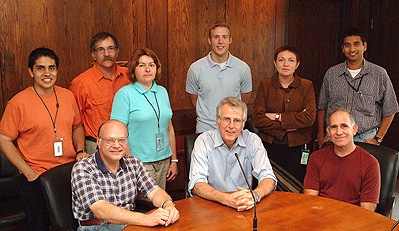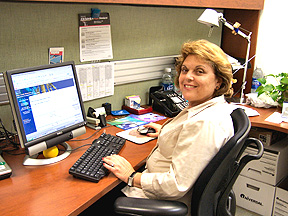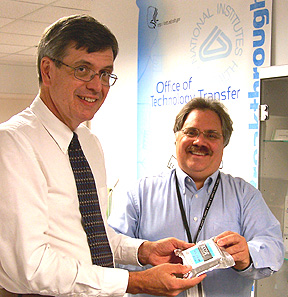 |
Larry
Keefer’s NCI-Frederick lab group: (sitting, left to right)
Joseph Hrabie, Larry K. Keefer, Joseph Saavedra; (standing, left
to right) Carlos Velazquez, Michael Citro, Daniela Andrei, Geoffrey
Lynn, Ana Maciag, and Harinath Chakrapani |
 |
|
Informationist
Barbara Brandys displays chemistry structure data she enhanced for
Larry Keefer’s group at the Laboratory of Comparative Carcinogenesis,
NCI |
GOOD CHEMISTRY
Barbara Brandys joined the NIH Library in 1997 and became an informationist in 2004. She provides information services to various NIH groups, including the Drug Information Service at the Clinical Center.
After receiving her undergraduate degree in chemistry, she worked as a science teacher and then as a chemist in the private sector. Brandys speaks several languages, including English, Hebrew, and Polish, and also serves as a volunteer translator in the Clinical Center.
Larry Keefer, head of the Chemistry Section and chief of the NCI Laboratory of Comparative Carcinogenesis (LCC), has worked with Brandys for more than five years. "One of the challenges we were struggling with was setting up a website for compounds. We needed the structures and data uploaded," said Keefer.
Brandys joined on to convert the structures to images and enhance links to relevant data and publications for the Nitric Oxide Donors database.
The LCC patents compositions of matter with the intention of making them widely available for pharmacological screening. If a compound has a commercial application, say, as an effective anticancer agent, a material transfer agreement can be signed and licensing can be obtained through NIH.
Brandys’ knowledge of chemistry and information management allows her to search and locate accurate compound properties and make expert contributions to the LCC website.
Keefer is impressed with Brandys’ work. He said that "when the group publishes an article with a new compound in it, she pulls chemical parameters from the methods section and uploads them to the database."
Brandys
specializes in chemistry/structures, drug information, and toxicology
searches and provides chemistry resources seminars to chemistry-focused
groups within NIH. Recently, Brandys started to work on the design and
development of a new compound database for the Imaging
Probe Development Center.
![]()

